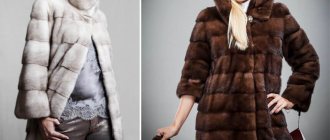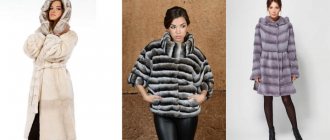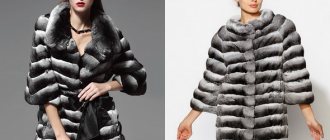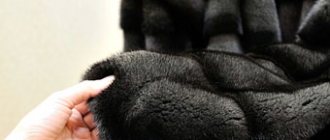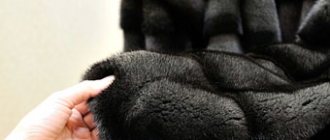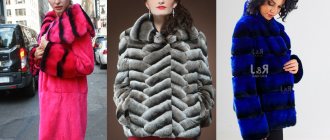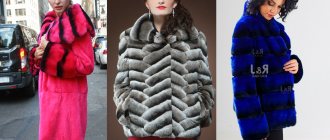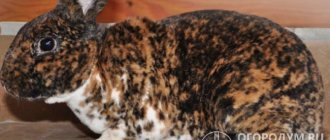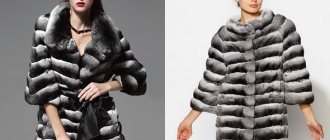Chinchilla fur coats: short and long model from the catalog
A chinchilla fur coat is incredibly beautiful, and its fur has an amazing structure that cannot be compared with any other fur. There are very few of these animals left in natural conditions, and it is difficult to raise them artificially. Let's talk about how to choose a chinchilla fur coat: a variety of styles.
Chinchilla fur coat
Peculiarities
Fur products are made only from the skins of animals raised on special farms. Sewing one chinchilla fur coat takes a huge amount of skins. For this reason, such products are very expensive. The main advantage of chinchilla fur is its ability to retain heat perfectly. The interesting thing is that from each subcutaneous bulb a whole bunch of villi grows, which make this fur so fluffy and warm. Any woman will look chic in luxurious chinchilla clothes.
However, it is worth knowing that there is rex rabbit fur that is very similar to chinchilla. Products made from this fur have become quite popular among fashionistas in recent years. A chinchilla rabbit fur coat, compared to natural chinchilla fur, has an affordable price.
Interesting read
Fur coat styles
Leafing through the catalog, you may notice that products made from the skins of this animal are mainly used in simple styles. In this case, the goal of the designers is to focus all the attention on the beauty of the fur.
It is very rare to find a floor-length chinchilla coat. Basically, these are styles such as jackets, capes, flared cropped coats, etc. Products made from this exquisite fur are an item of special status. They cannot be a thing for daily wear. Look at the photo how chic a short chinchilla fur coat looks.
The skin of a real chinchilla animal has an original and rich color. A dark stripe with a pleasant pearl sheen runs along the back. Pure gray and white stripes extend from it. That is why when creating a product they use models with cross stitching. Only in rare cases are chinchilla skins sewn lengthwise. This is what a chinchilla fur coat looks like in the photo.
It is worth noting that this fur is practically not used for sewing models that can be worn in harsh winters. However, it is considered not only the most delicate and airy, but also warm. Despite the fact that chinchilla fur does not have undercoat, it is endowed with excellent density due to its special properties.
What colors are there?
Thanks to the successful crossing of a chinchilla with a rabbit, today there is fur from which original fur coat models are created. The skins have almost the same color as natural chinchilla fur. At the same time, depending on the manufacturer, options with completely different shades have appeared.
Now on the fur market you can find products made from blue, ash, cream fur, as well as dark colors. However, experts give the highest rating only to material that has natural colors. These skins have all the necessary qualities, however, their pile is not as long and luxurious as natural ones. Today you can even find products made from red chinchilla, which also find their buyer.
Chinchilla and mink combinations
Of course, they try to use such aristocratic fur as chinchilla delicately. It is never dyed, cut or lasered. Also, designers use those models and styles that demonstrate the natural beauty of this fur. Sometimes they achieve such unusual beauty of a product that it becomes a real masterpiece.
Very often, luxurious chinchilla fur is used as a decorative finish on products made from other types of fur. These can be details such as a hood, collar, etc. The most common version of this combination is mink with elements of chinchilla fur. Moreover, sheared mink with fluffy fur looks especially beautiful.
How to distinguish a chinchilla from a rabbit
Chinchilla fur is often replaced with the fur of a Rex rabbit or “beaver”. At first glance they are very similar to each other. Reviews about chinchilla rabbit fur coats are often positive; these furs have completely different price categories.
In fact, a chinchilla fur coat can be easily distinguished from a fake. A chinchilla fur coat has a long pile, and it is never cut. Rabbit fur today is usually produced in shorn form. A color that clearly differs from the natural material indicates that it is a fake. An elegant chinchilla fur coat can only be purchased in an expensive boutique, and not in a dubious place at an inexpensive price.
Before buying a fur coat, check all these points well. If in doubt, it is better to refuse this purchase, which is not worth the money. This fur coat has no exclusivity and will quickly upset you. It is worth noting that chinchilla fur coats are not widely produced. They are mainly created to order by high-class craftsmen or in famous fashion houses.
shubyinfo.ru
How to determine the authenticity of fur
Buying a chinchilla fur coat involves significant financial expenses. And it’s a shame if instead of luxurious, stylish clothes they sell you a rabbit. When you go shopping, remember:
- There are no cheap chinchilla fur coats (low quality skins cost $50, minimum 100 pieces, plus tailoring and design).
- The size of chinchilla skins is small, no larger than the palm of your hand.
- Completely odorless.
- Light weight, almost weightless.
- A chinchilla's fur is cool to the touch, while a rabbit's is warm.
- The pile on the chinchilla's belly and spine is shorter than on the back and sides.
- Rabbits shed, chinchillas never do.
The uneven length of the fur makes the product wavy. And the heterogeneous color of the fibers creates a play of color. The special structure of the pile and its density will always allow you to distinguish a chinchilla from a fake. The easiest way to determine the naturalness of fur is to hold the fur coat on its weight. The product is light, almost weightless. Rabbit fur coats are much heavier.
You shouldn’t take the word of sellers without a reputation. By checking the product using several methods, you can easily identify a fake. If you doubt the seller’s cleanliness, postpone your purchase. It is safer to find another fur clothing dealer who will offer a natural chinchilla fur coat without hidden tricks. of your page —>
Product care rules
Such capricious material as chinchilla fur requires special care. A chinchilla fur coat is an expensive item, so you need to take proper care of it in order to maintain its presentable appearance for as long as possible. Care rules:
- Chinchilla fur does not tolerate water. To prevent getting wet, the animals bathe in sand, this allows them to keep their fur intact. A chinchilla fur coat should not be worn in rainy weather, as moisture will ruin the fur. If the item could not be protected from rain or sleet, it should be dried at room temperature as soon as possible.
- It is strictly forbidden to wash or clean the product yourself. The same applies to ironing. Fur does not tolerate high temperatures well. If a fur coat is dirty, it should be taken to the dry cleaner, making sure to warn the employees that it is chinchilla fur.
How to distinguish a chinchilla fur coat from a rabbit fur product?
Chinchilla fur has always been considered the most expensive. 100 years ago, a chinchilla fur coat was valued at half a million gold marks. Today you will have to pay more than 20 thousand dollars for it.
High cost, rare animal - such features give rise to fraud, and chinchilla fur is often passed off as rex rabbit or beaver fur. How not to fall for the trick of scammers and distinguish a fake from a real thing?
First of all, you need to pay attention to the cost of the fur coat. Too low a price, discounts, sales should alert you. You shouldn’t be happy that you were able to buy such an expensive item at a cheap price, because, most likely, the low price indicates a fake.
You should only buy a fur coat in a specialized store of well-known brands. Before purchasing, you should ask the seller for a certificate for the product. It must indicate the material from which the item is made. You should not buy a fur coat in markets or dubious stores. You should also be wary if the seller refuses to show the certificate.
The difference between the fur of a rex rabbit and a chinchilla can be felt even by touch. Chinchilla wool is very soft to the touch and resembles down. The hair of the Rex rabbit is much tougher, it is less dense, but at the same time more elastic.
How to choose the right chinchilla fur coat
February 16, 2015
It is known that chinchilla fur and products made from it are considered a real luxury. It's expensive, unique and simply adorable. That is why it is imperative to select products made from the fur of these animals with special care.
The most popular mistake
You need to be especially careful, because the Rex rabbit is very similar to the chinchilla. Inexperienced buyers can easily confuse them, and it is known that rabbit fur is much cheaper.
That is why you need to remember the most important criteria that you should pay attention to when choosing this product, so as not to purchase a fur coat that was made from a rabbit and then disguised as a chinchilla. It is clear that this is unlikely to happen in a branded boutique, but it is better to be safe.
Main characteristics of chinchilla fur
It is known that fur should be light, almost weightless. It is clear that it costs a lot, so there is no point in hoping to purchase a quality product if its price is too cheap compared to the real one.
The size of the skin itself and the pile deserve special attention. It is known that the skin of a chinchilla is much smaller than a rabbit - on average, it is smaller than the palm of your hand. By examining the fur by touch, you can determine its origin, because a chinchilla's fur should be soft. This softness is ensured by the fact that one hair follicle contains more than fifty hairs. Unlike the chinchilla, the rabbit has rather coarse fur.
To make a fur coat, the entire skin is used. That is why the places where the skins are connected to each other are distinguished by the absence of hair. If the skin was cut correctly, then the bellies simply remain on the sides, because in such places the fur is short. Thus, the finished fur coat is slightly wavy. Using rabbit fur, a similar effect cannot be achieved.
In addition, the feeling of iridescence occurs due to the slight heterogeneity of the animal’s color. Chinchilla fur is always a little cool, but rabbit fur becomes the same temperature as the room.
When choosing, you need to read the label correctly, because sometimes it may say “chinchilla rex”, in which case you can safely say that this thing is made from rabbit.
Sometimes characteristic stripes are painted on a fur coat with simple dyes, so you need to smell it - the smell of the paint will be felt if it was used. The fur itself has no odors, because it does not have sweat or sebaceous glands.
shuba-dly-vas.ru
Why is chinchilla fur considered exclusive?
Chinchilla fur is in the top three most elite furs in the world. The cost of one skin is from 50 to 600 USD, and prices for natural fur coats start at 10 thousand dollars. Fur is valued and considered exclusive due to several features:
- Strong pile density
- Hair length up to 3 cm
- Heterogeneous colors
- Small skins
- The fur is soft, warm, light
- Extraordinary beauty and luxury
Chinchillas have very thick hair. Up to 80 hairs grow from one hair follicle. Their thickness does not exceed 0.01 mm. The cover is silky, soft and feels more like down. The length of the fibers is up to 3 cm. In combination with their thinness, the fur is very light in weight.
The heterogeneous coloring of the villi gives them amazing beauty. Variations of shades from dark to mother-of-pearl. Due to the small size of the rodent, sewing a fur coat will require at least 100 skins. The clothes look luxurious. The cost of exclusive models can reach hundreds of thousands of dollars.
Luxurious clothing requires the ability to wear it
A chinchilla fur coat is not worn as regular clothing. It is worn rarely, for special occasions and worn with caution. The beauty and luxury of clothing sets a woman apart from those around her, attracts attention, and impresses. But such clothing requires careful handling, otherwise it quickly becomes unusable.
The cover can quickly become greasy when touched, and the villi stick together. Even light mechanical impacts lead to breakage of thin pile. The base of the skin can easily tear, especially if the clothes get wet. Even restoration will not help restore the former beauty of a chinchilla fur coat.
Chinchilla fakes
Nimble “businessmen” take full advantage of consumers’ ignorance. They offer to buy fake fur coats made from cheaper fur, passing them off as chinchillas. Used to deceive:
- Rabbit
- Rex
- Orylag
The last two belong to specially bred breeds of rabbits, the fur of which is very similar to that of a chinchilla. Sellers assure buyers that the goods they sell are natural. And often they manage to convince the client to make a purchase.
In pursuit of the jackpot, swindlers dye the rabbit and cut the skins to fit the size of a chinchilla. When asked why the cost of a fur coat is low, they come up with fabulous stories about a special breed of chinchilla rex. By reading some tips before purchasing, you can easily spot a fake.
Appearance and properties of animal fur
There are more than 25 thousand villi per centimeter of skin. From each hair follicle, 60–80 hairs grow simultaneously. The thickness of downy hair is 12–16 microns, covering hair is 24–28 microns.
Such a high density of wool has additional advantages, in addition to thermoregulation. Not a single parasite can survive in it, so chinchillas are protected not only from cold and wind, but also from fleas and ticks.
Tanned chinchilla skins
Under natural conditions, chinchilla fur is gray and blue-gray in color. In captivity, it was possible to breed several mutational and interspecific varieties that have silver, beige, black, white, and motley fur.
How many skins are required to sew one product? The valuable skin is the reason that the species is on the verge of extinction and is listed in the Red Book. The hunting of animals for fur began in the 19th century, since then their numbers have been rapidly decreasing, because about 100 skins are required for one fur coat.
At the end of the 20s of the 20th century, animals began to be bred on special farms in order to stop the extinction of the species. Thanks to farms, it was possible to increase the population by 65%. Since the middle of the last century, the catching of wild chinchillas has practically ceased, but poaching has not yet been eradicated.
Myths about fur| Chinchilla | RussModa Magazine
As I once already started my material about a llama, which is a camel, now: a chinchilla is a rodent. To be honest, among our friends we always called it a mouse, although this is not entirely correct. Chinchilla is a species of rodent of the chinchilla family. This species is very rare in the wild. Found only in the Andean highlands of Chile. The homeland of chinchillas is South America. Short-tailed chinchillas live in the Andes of southern Bolivia, northwestern Argentina and northern Chile. The long-tailed chinchilla is currently found only in a limited area of the Andes in northern Chile. Chinchillas inhabit dry rocky areas at an altitude of 400 to 5000 meters above sea level, preferring northern slopes. Rock crevices and voids under stones are used as shelters; if they are absent, the animals dig a hole. Chinchillas are perfectly adapted to life in the mountains. Chinchillas are monogamous. According to some reports, life expectancy can reach 20 years.
Chinchillas lead a colonial lifestyle; They eat various herbaceous plants, mainly cereals, legumes, as well as mosses, lichens, cacti, shrubs, tree bark, and animal food - insects. A consequence of living in a cold mountain climate is thick and warm fur. Chinchillas hold the record for fur density among animals - there are more than 25,000 hairs per square centimeter of skin. Such a high density is ensured by the unusual structure of the fur: 60 - 80 very fine hairs grow from each hair follicle. Chinchilla fur is so dense that it cannot harbor parasites common to other fur-bearing animals. Chinchillas do not have sweat and sebaceous glands; when they get into water, their fur immediately gets wet, and the animal cannot stay on the surface. To get rid of moisture, remove lost hair and clean fur, chinchillas regularly bathe in volcanic ash and fine dust, as well as fine sand.
The uniqueness of chinchilla fur is associated precisely with the increased pubescence that I noted above. The fact is that with such a density of hairs, the animal also needs thick skin, otherwise the hair will simply have nothing to hold on to. When working with fur, this feature is very difficult, since instead of “clothing” the material is more like haberdashery - it is so hard. To solve this problem, fur producers resort to “fleshing” - removing the subcutaneous layer from the skin - the flesh. The process itself is very complex and labor-intensive; there are very few specialists in this field. Proper processing of the skin requires serious concentration and manual work, because in this situation you can always overdo it, and then the hairs will have nothing to hold onto - the skin will fall apart.
Having provided an extensive theoretical basis, we can finally talk about fur itself and the production of clothing from it. There is an opinion that chinchilla is an exclusively catwalk fur, and not only because it is beautiful, but also because it is unusually vulnerable. The vulnerability of fur is manifested in the fact that it tears very easily - constantly, endlessly and for any reason. Turned wrong - there's a hole. It will also not be possible to sit on a chinchilla fur coat - it will instantly tear. The fur literally tears under its own weight, because with such a thin leather base, the number of hairs does not decrease. This feature immediately puts an end to the desire to wear things made from this fur every day; this is simply impossible if you don’t want to visit a studio once a week that will darn your fur coat. However, it should be noted that if you already have such a thing, and you did not understand why it tears so mercilessly, now you know that there is nothing wrong with this, it is a natural consequence of production technology.
Fears and negative experiences can be limited to one paragraph, and now we can finally move on to the positive qualities, because the chinchilla has much more of them. Let's start with the fact that this is very beautiful fur. It is so beautiful that it cannot be confused with anything else. The main reason for such extraordinary beauty is the graphic nature of the skins. The chinchilla has an even black ridge on its back and a white belly - when laid out “crosswise”, an absolutely even and perfect black and white pattern is created. In addition, the skin is short-haired and slightly convex, which is why it resembles light, even waves. This pattern cannot be achieved with any other fur. The second and, in my opinion, the most important feature is the softness of the fur. This softness cannot be compared with anything. If you have ever touched at least one chinchilla skin in your life, you will agree with me - this is the standard of softness. This is not a feather, not clouds, not cotton candy - this is space. And finally, chinchilla is warm fur. Warm enough to keep you warm in a very cold winter, protect from wind and all kinds of cold. The only problem is that you can’t get caught in the rain, because this sweet skin does not tolerate moisture on a chemical level.
As in all our stories, there is also a myth and its destruction involved. This myth is a cheap chinchilla. No, that doesn't happen. Due to the dressing technology we have already described, the rarity of origin and the small size of the skin, it is very expensive - on the same level as sable and lynx. The fur industry is extremely cunning and resourceful. When manufacturers and sellers felt an increased demand for chinchilla, they realized that there was no way to make it cheaper, but there was a chance to produce something similar, but less expensive. Then a special type of rabbit was bred, whose fur is so similar to a chinchilla that only a very savvy specialist can distinguish them in the finished product. There are two types of “chinchilla” rabbits: orylag and rex. Both belong to the family of hares, superorder - chinchillas.
Rex rabbits were first presented at the Paris Rabbit Breeding Exhibition, held in 1924, and the following year this breed, obtained by crossing the Royal German rabbit with a regular breed of rabbits with non-dominant genes, was officially registered. From that moment on, it began to quickly spread throughout Europe. Typically, a standard Rex rabbit weighs between 3.5 and 4.5 kg. In addition, a decorative variety of Rex rabbits has been bred - the so-called mini-Rexes: from 1.8 to 2 kg. Nowadays, selection work with the short-haired breed of rex rabbits is carried out by purebred breeding exclusively for the production of fur skins.
Orylag is the result of long and painstaking work by French fur breeders. Funds for its breeding were specially allocated by the French government, and therefore orylag is bred exclusively in France. Its homeland is considered to be the region of Poitou-Charentes and Charente-Maritime.
The best Rex rabbits were collected from all over the world and selection was carried out for 15 years. The result exceeded all expectations - the orylag fur is high quality, warm, wears well and is very beautiful. After all, the initial task when breeding orylag is for its fur to be similar to chinchilla fur, but to be much cheaper. The difference in price between a chinchilla and an orylag is threefold, the cost of a rex is even two times lower.
Wanting to maintain a certain circular composition of my texts, I will end where I started. A chinchilla is a rodent. Moreover, it is very rare, beautiful and with character. A chinchilla fur coat is luxury, a reflection of status, sophistication and femininity, but the item is completely optional to purchase. Here I express a subjective opinion, so I can say whatever I want. If your life consists of social events, trips to the theater and receptions at the royal court, a chinchilla is perfect. If you want to look stylish and feel warm without being limited by your budget, choose sable.
www.russmodamag.ru
